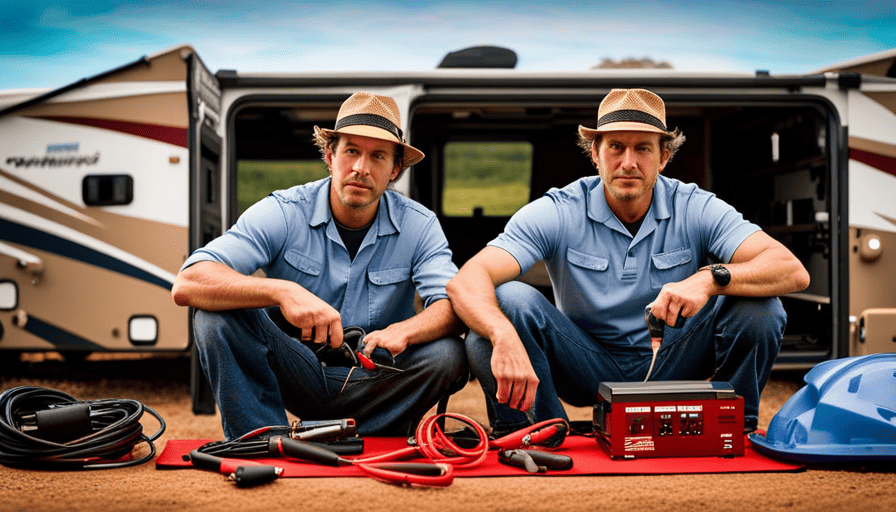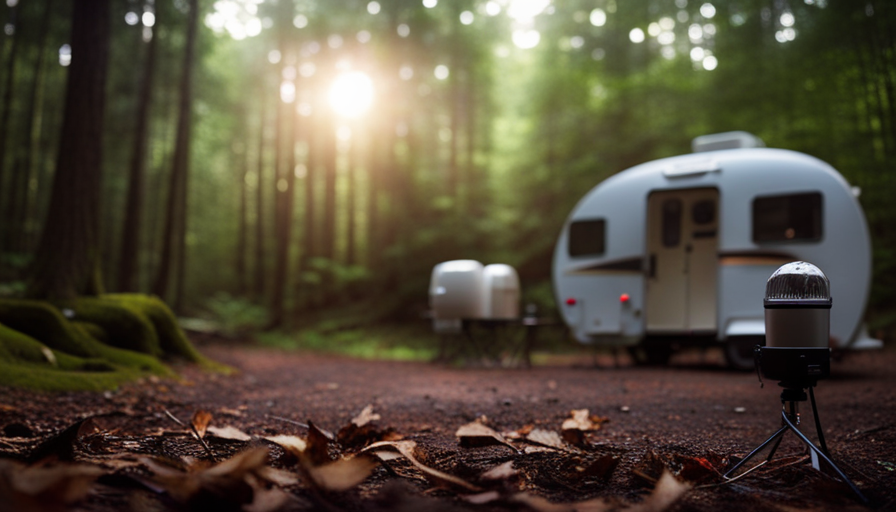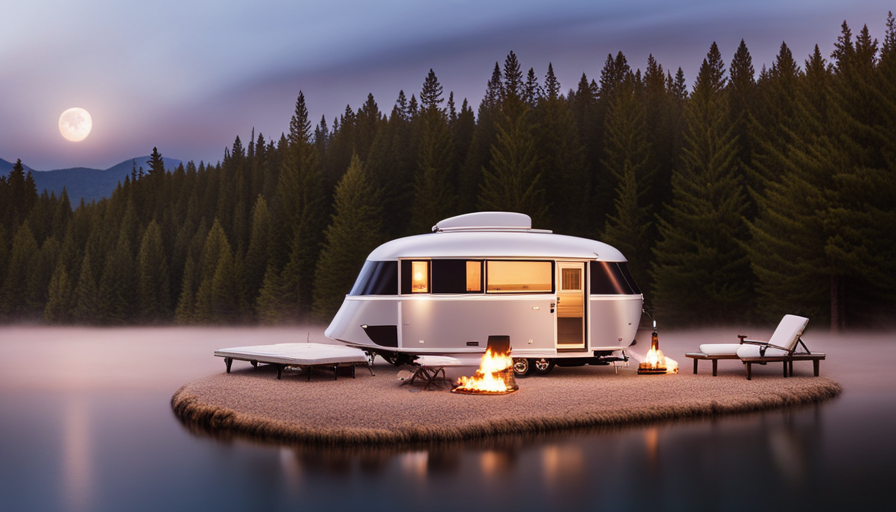While gazing up at the scorching sun from outside my RV, I realized that it was the ideal time to set up an awning for the camper. The thought of constructing a cool, sheltered oasis to relax in while camping excited me. With all the required supplies and equipment in hand, I was ready to embark on the installation adventure.
In this article, I will guide you through the precise steps of installing a camper awning. From measuring and marking the installation area to attaching the awning rail and installing the awning arms, I will provide you with detailed instructions to ensure a successful installation.
Once the awning is installed, I will show you how to test it for proper functioning and make any necessary adjustments or tightenings. Additionally, I will share tips on how to maintain and care for your camper awning, ensuring its longevity.
So, if you’re ready to enjoy the comfort and convenience of a camper awning on your next camping trip, let’s get started!
Key Takeaways
- Gather necessary materials and tools
- Choose the right size awning for proper fit
- Take safety precautions such as using a sturdy ladder and wearing appropriate gear
- Follow manufacturer’s instructions and seek professional assistance if needed throughout the installation process
Gather the Necessary Materials and Tools
Before you begin installing your camper awning, make sure you have all the materials and tools you’ll need.nnChoosing the right size awning is crucial to ensure a proper fit for your camper.nnMeasure the area where you plan to install the awning and select a size that matches those measurements.nnAdditionally, consider safety precautions during installation.nnIt’s essential to have a sturdy ladder that can support your weight and reach the installation area.nnAlways wear appropriate safety gear, such as gloves and goggles, to protect yourself from any potential hazards.
Once you have the necessary materials and tools, you can proceed with the installation process.nnStart by marking the area where you will install the awning.nnUse a measuring tape to ensure accuracy and mark the positions for the mounting brackets.nnMake sure the area is clean and free of any debris that could hinder the installation process.nnThis will ensure a secure and stable mounting for your camper awning.
With the area measured and marked, you are now ready to move on to the next step of installing your camper awning, which is attaching the mounting brackets.
Measure and Mark the Installation Area
First things first, grab your measuring tape and get ready to unleash your inner architect. When it comes to installing a camper awning, measuring accuracy is crucial for a successful installation. You want to ensure that the awning fits perfectly and functions properly.
Start by measuring the area where you plan to install the awning. Measure the length and width of the space, making sure to account for any obstructions such as windows or doors. It’s also important to consider the height of the awning, as you don’t want it to obstruct any existing features of your camper.
Once you have the measurements, it’s time to mark the installation area. Use a pencil or chalk to mark the spots where the mounting brackets will be placed. Be precise and double-check your measurements to ensure accuracy. If you’re unsure about the placement, you can use a level to ensure that the markings are straight and even.
Now that you have measured and marked the installation area, it’s time to move on to the next step. Prepare the mounting brackets by attaching them securely to the marked spots. This will provide a sturdy and stable foundation for your camper awning.
Prepare the Mounting Brackets
Now that you’ve measured and marked your installation area, it’s time to get those mounting brackets ready for action! Choosing the right mounting brackets for your camper awning is crucial for a secure and stable installation. When selecting your brackets, make sure they’re specifically designed for your camper model and awning type. This will ensure a perfect fit and prevent any future issues.
Before installing the brackets, it’s important to properly align them for optimal stability. Start by holding the bracket up to the installation area and visually check if it lines up correctly. Use a level to ensure that the brackets are straight and perpendicular to the ground. This step is essential to guarantee that your awning will be properly supported and won’t sag or cause any structural problems.
Once you’ve chosen the right mounting brackets and properly aligned them, you’re ready to attach the awning rail to the camper. This step will secure the awning to your camper and provide a sturdy foundation.
Attach the Awning Rail to the Camper
Once you’ve chosen the perfect mounting brackets, how do you securely attach the awning rail to your camper? There are several attachment methods you can use to ensure a strong and secure connection. One common method is to use self-tapping screws to attach the awning rail to the camper’s exterior wall. Make sure to position the rail at the desired height and use a level to ensure it is straight. Another option is to use adhesive tape specifically designed for outdoor use. This tape creates a strong bond between the awning rail and the camper’s wall. Whichever method you choose, it’s important to follow the manufacturer’s instructions and use the correct tools for the job.
To help you visualize the process, here’s a table outlining the steps for attaching the awning rail:
| Step | Attachment Method |
|---|---|
| 1 | Self-tapping screws |
| 2 | Adhesive tape |
| 3 | Follow manufacturer’s instructions |
When attaching the awning rail, it’s important to avoid common installation mistakes. One mistake to avoid is overtightening the screws, as this can damage the camper’s wall. Another mistake is not cleaning the surface properly before applying adhesive tape, which can result in a weak bond. Taking the time to carefully attach the awning rail will ensure a secure and long-lasting installation.
With the awning rail securely attached to your camper, you’re now ready to move on to the next step: installing the awning arms.
Install the Awning Arms
To start the process, you’ll need to attach the awning arms to your camper’s exterior. The awning arms are responsible for supporting and extending the awning fabric, providing shade and protection.
Before installing the arms, make sure you have all the necessary tools and equipment, such as a drill, screws, and a ladder.
First, locate the designated area on your camper where the awning arms will be mounted. It’s crucial to follow the manufacturer’s instructions and measurements to ensure proper installation. Attach the arms securely using the provided screws, making sure they are aligned and level.
Once the awning arms are securely in place, you can proceed to install the awning fabric. This involves sliding the fabric into the groove on the roller tube and then attaching it to the arms using the provided hooks or clips. Make sure the fabric is evenly spread and taut to prevent sagging or flapping during use.
If you encounter any issues during the installation process, such as difficulty attaching the fabric or troubleshooting awning issues, consult the manufacturer’s instructions or seek professional assistance.
Now that the awning arms are installed, it’s time to move on to the next step: extending and securing the awning fabric.
Extend and Secure the Awning Fabric
After successfully attaching the awning arms, it’s time to extend and secure the fabric for optimal shade and protection.
To extend the awning fabric, locate the fabric roll and gently pull it outwards. Make sure to extend it evenly and smoothly to avoid any wrinkles or creases. Once fully extended, lock the fabric in place by engaging the locking mechanism on the awning arms. This will ensure that the fabric remains taut and secure.
Next, it’s important to secure the awning fabric to prevent it from flapping or coming loose in windy conditions. Begin by attaching the fabric to the awning arms using the provided hook and loop fasteners. These fasteners should be securely fastened along the entire length of the arms to keep the fabric in place. Additionally, some awnings may have additional securing mechanisms such as straps or buckles. Follow the manufacturer’s instructions to properly secure the fabric using these features.
With the awning fabric fully extended and securely fastened, you’re now ready to test the awning for proper functioning. This will ensure that the fabric is properly tensioned and that all components are working correctly.
Test the Awning for Proper Functioning
Now it’s time to make sure your new awning is in tip-top shape by giving it a spin and checking for any glitches. Testing the awning for proper functioning is an essential step to ensure that it operates smoothly and effectively.
One common issue that may arise is difficulty retracting or extending the awning. If you encounter this problem, first check if there are any obstructions blocking the movement of the awning fabric. Additionally, ensure that the fabric is properly aligned and not caught on any parts of the awning mechanism. If the awning still doesn’t extend or retract smoothly, you may need to adjust the tension in the springs or lubricate the moving parts.
Another important consideration is choosing the right awning fabric. Make sure the fabric is durable, weather-resistant, and matches the style of your camper. Additionally, check that the fabric is properly secured to the awning frame to prevent any sagging or flapping in strong winds.
Once you have tested the awning for proper functioning and troubleshooted any common issues, it’s time to move on to the next step of adjusting and tightening the awning as needed.
Adjust and Tighten the Awning as Needed
Ensure your awning is secure and properly aligned by adjusting and tightening it as needed. Proper adjustment techniques are essential to ensure the awning functions correctly and doesn’t pose any safety risks.
Here are some troubleshooting tips to help you get it right:
-
Check the tension: Start by verifying the tension on the awning fabric. If it’s too loose, it may sag or flap in the wind. If it’s too tight, it can put unnecessary strain on the awning components. Adjust the tension by using the awning’s adjustable arms or tension knobs.
-
Align the arms: Make sure the arms of the awning are properly aligned with the camper. Misalignment can lead to difficulties in opening, closing, or even damage the awning. Use a level to ensure the arms are straight and parallel to the ground.
To maintain and care for your camper awning, it’s important to regularly inspect and clean it. Regularly remove any debris such as leaves, dirt, or bird droppings. Additionally, make sure to follow the manufacturer’s instructions for any specific maintenance requirements.
By properly maintaining your camper awning, you can extend its lifespan and ensure it continues to provide shade and protection during your camping adventures.
Transitioning into the subsequent section about maintaining and caring for your camper awning, it’s important to keep in mind that regular maintenance is key to keeping your awning in top shape.
Maintain and Care for Your Camper Awning
To keep your camper awning in optimal condition, it’s crucial to regularly inspect and clean it, ensuring its longevity and effectiveness. Maintaining your camper awning is relatively simple and requires some basic care.
First, inspect the awning for any signs of damage, such as tears or loose parts. If you notice any issues, address them promptly to prevent further damage.
Additionally, clean your awning regularly to remove dirt, debris, and mildew. Start by brushing off any loose dirt or debris with a soft brush or broom. Then, mix a mild soap solution and gently scrub the awning using a soft sponge or cloth. Rinse thoroughly with water and allow it to air dry completely before retracting.
Finally, make sure to store your awning properly when not in use. Roll it up tightly and secure it with straps or bungee cords to prevent any damage from wind or weather conditions.
By maintaining and caring for your camper awning, you can ensure that it will provide shade and protection for many camping trips to come. Enjoy your new camper awning on your next camping adventure!
Enjoy Your New Camper Awning on Your Next Camping Trip!
Get ready to have an amazing time on your next camping adventure with your brand new camper awning! Having an awning on your camper can enhance your camping experience by providing shade and protection from the elements.
Here are some enjoyment tips and camping hacks to make the most out of your new camper awning:
-
Create a cozy outdoor living space: Set up some comfortable chairs, a table, and maybe even a hammock under your awning. This will give you a dedicated area to relax and enjoy the outdoors.
-
Utilize outdoor lighting: Hang some fairy lights or lanterns around your awning to create a warm and inviting atmosphere in the evenings. It’ll not only provide functional lighting but also add a touch of charm to your camping setup.
-
Stay organized: Use hanging organizers or hooks to keep your camping gear, utensils, and other essentials easily accessible. This’ll help you stay organized and ensure that everything is within reach when you need it.
-
Protect against bugs: Use a mesh screen or bug netting around your awning to keep pesky insects at bay. This’ll allow you to enjoy the outdoors without worrying about being bitten.
By following these enjoyment tips and camping hacks, you can make the most of your new camper awning and create unforgettable memories on your next camping trip. Happy camping!
Frequently Asked Questions
How long does it typically take to install a camper awning?
Typically, it takes around 2-3 hours to install a camper awning. However, before installation, it’s important to measure the area where the awning will be installed. To do this, measure the length of the camper’s roofline and determine the desired projection.
Additionally, regular maintenance is crucial for prolonging the lifespan of your awning. Clean it regularly, inspect for any damages or tears, and lubricate moving parts. Following these tips will ensure your camper awning stays in great condition for years to come.
Can I install a camper awning on any type of camper?
Installing a camper awning on any type of camper is like trying to fit a square peg into a round hole. It’s not impossible, but it definitely requires some careful consideration.
Choosing the right awning for your camper is crucial, as different campers have different dimensions and mounting options. Take measurements, research compatible awnings, and consult with experts to ensure a successful installation.
Don’t let your camper suffer from an awning identity crisis!
Are there any special tools required for installing a camper awning?
There aren’t any specialty awning tools required for installing a camper awning. However, it’s recommended to have a few basic tools on hand such as a drill, screwdriver, and measuring tape. These tools will be used to securely attach the awning brackets and hardware to the camper.
In some cases, alternative installation methods may be used, such as adhesive or suction cup mounts, but these may not provide the same level of stability and durability as traditional installation methods.
How do I know if the awning fabric is properly secured?
You might think checking the tension of your awning fabric is a piece of cake, but let me tell you, it’s not as easy as it looks.
To ensure your awning is properly secured, start by inspecting the fabric for any signs of looseness or sagging. If you notice any issues, don’t panic! Simply tighten the tension knobs or use a ratchet strap to tighten the fabric.
Trust me, it’s worth the effort for a secure and sturdy awning.
What should I do if my camper awning gets damaged?
If my camper awning gets damaged, I’d take immediate action to prevent further damage. First, I’d assess the extent of the damage, paying close attention to the fabric, frame, and any structural components. Depending on the severity of the damage, I’d either attempt to repair the awning myself using a patch kit or seek professional assistance. Regular maintenance and inspections are crucial for preventing camper awning damage, so be sure to check for any signs of wear and tear regularly.
Can I Use the Same Installation Process for a Camper Shell and a Camper Awning?
When it comes to installing a camper shell and a camper awning, the process may vary. While installing a camper shell involves securing it onto the truck bed, installing a camper awning requires attaching it to the sidewall of the RV. Therefore, the installation processes for these two accessories are not the same.
Conclusion
In conclusion, installing a camper awning wasn’t an easy feat, but it was definitely worth it.
As I stood back and admired my handiwork, I couldn’t help but feel a sense of accomplishment.
The awning, like a graceful dancer, elegantly extended its arms, providing shelter and shade for my outdoor sanctuary.
With every gust of wind, it swayed gracefully, adding a touch of whimsy to my camping experience.
I knew that from now on, my camping trips would be elevated to a whole new level of comfort and style.











